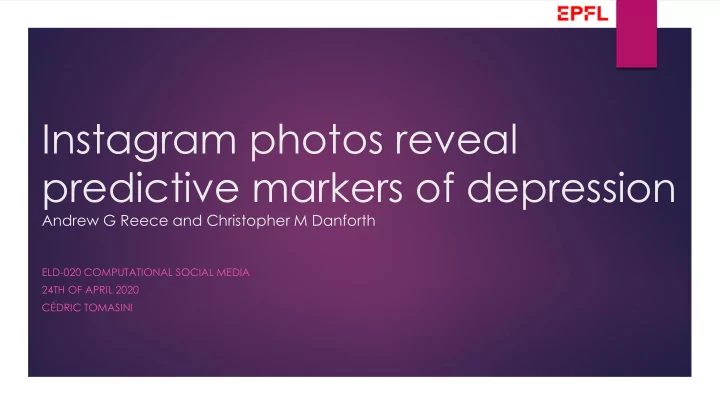

Instagram photos reveal predictive markers of depression Andrew G Reece and Christopher M Danforth ELD-020 COMPUTATIONAL SOCIAL MEDIA 24TH OF APRIL 2020 CÉDRIC TOMASINI
Goal Previous Main findings research Identify and predict markers • Detection of health of depression in Instagram • Can outperform user’s posted photographs. practitioner’s condition on online media through text diagnostics. In a computationally efficient analysis. way. • Results hold even • Study of depression before the users are on Instagram with diagnosed. unscalable • Human and qualitative methods. computers see things in a totally different manner.
Research hypotheses • Instagram posts from users with depression are distinguishable from healthy user’s posts, using only computational image features and metadatas. → Yes • Posts made before the diagnosis by users with depression are also distinguishable. → Yes • Human rating of posts based on semantic categories can also distinguish between posts from users with depression and posts from the control group. → Yes • Human-rated features are correlated with computational features → No
Method (Computational approach) Survey Sharing of whole Features posting history 43’950 Ensure: • User activity 95 control photographs No history of • • Community reaction depression users Active • • User social activity Instagram use (Face detection) Inclusion criteria • • Pixel-level HSV 71 with a Standard • clinical history of • Use of Instagram depression depression survey filters Demographics •
Method (Human approach) Rating Features: • Interesting ? • Likable ? • Happy ? • Sad ? To be rated on Batches of 0-5 scale. decontextualised images from the collected dataset
Method Bayesian logistic Supervised ML regression Goal: estimate the model’s Goal: measure strength of individual predictor predictive capacity All-Data model Features Pre-diagnosis model (Use all control group but only data from before the first diagnosis for depressed group) Null hypothesis model
Results • Posts by depressed users are on average bluer, darker, grayer (hue +, saturation -, brightness - ) • Depressed users posts more photos with one ore more faces, but the number of faces is lower . • Depressed users use less filters , and the filter choosen are different.
Results
Results • Inkwell filter = black-and-white • Valencia = tint lightening
Results (Human) • Sadness and happiness are the only significant predictors (in contrary to likability and interestingness). • Posts by depressed users are more likely to be sadder and less happy. • Extremely low correlation with computational features. • Both humans and machines are able to work out significant features, but in a very different way.
Results (Predictive models comparison) « without assistance from scales, questionnaires, or other measurement instruments. » → ? • Comparison: unassisted general practitioners. • Recall : TP/(TP + FN), true depression diagnosis among all depressed subjects. All-data > Practitioners. • Specificity: TN/(TN + FP), true non-depression diagnosis among all healthy subjects. Practitioners All-data model Pre-diagnosis model Bad because Recall 51% 70% 31% too few data ? Specificity 81% 48% 83%
Conclusion • Highlight: cheap, scalable and can outperform practicers diagnoses. • Possible usage: Area where health is underdeveloped ; Complementary tool to prevent false diagnoses. • Privacy issue: users must agree to share their data. What are the ethical implications? • Voluntary participation issue: Were the participants biased? Representative? What «depression» means for them? • Diachronic validity issue: Are those results dependent of trends?
Recommend
More recommend